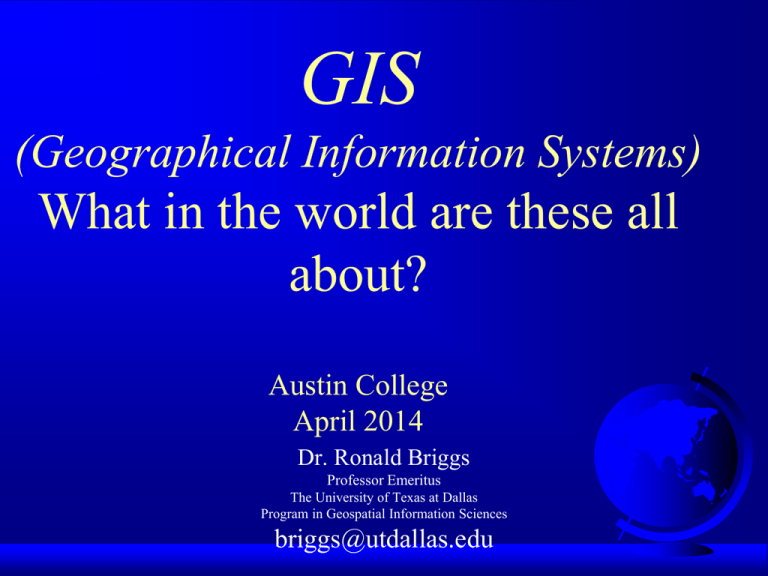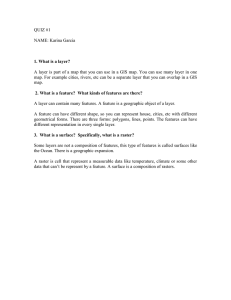GIS What in the world are these all about? (Geographical Information Systems)
advertisement

GIS (Geographical Information Systems) What in the world are these all about? Austin College April 2014 Dr. Ronald Briggs Professor Emeritus The University of Texas at Dallas Program in Geospatial Information Sciences briggs@utdallas.edu Overview Geographic Information technologies GIS data concepts Applications in environmental studies What is Geography? The science of location What is Where and Why the Spatial Science What? Where? Why? ? Briggs Henan University 2013 3 Geographic Information Technologies GIS: one of three technologies which have revolutionized the handling of spatial or locational data, which is the focus for geography (and most environmental studies) 1. 2. 3. Global Positioning Systems (GPS) Remote Sensing (RS) Geographic Information Systems (GIS) Made it easy to do things which in the past had been time consuming, expensive, or even impossible . Geographic Information Technologies 1. Global Positioning Systems (GPS) – a system of earth-orbiting satellites which provide precise location on the earth’s surface – GPS gave us exact locations inexpensively – didn’t need an expensive surveyor Geographic Information Technologies 2. Remote Sensing (RS) – collecting data without direct contact with the object being measured – use of satellites or aircraft to capture information about the earth’s surface – Expensive field surveys far less necessary – Especially important for environmental applications Geographic Information Technologies 3. Geographic Information Systems (GIS) – Software systems for input, storage, retrieval, analysis and display of geographic (spatial) information Input Analysis Display gave us inexpensive map production/display and easier analysis – don’t need a professional cartographer – But still need analysts! The Synergism of Three Technologies – GPS and Remote Sensing provide data for GI Systems. – GI Systems allow the effective use of GPS and RS data. GI Systems The evolution of GIS: from PhD to Google Earth 1960s: term GIS invented by Roger Tomlinson working for the Canada Land Inventory – Big country, few people, needed system to manage its natural resources 1990s: GIS emerged as a tool for researchers – As an example, I gave a talk in 1996 to researchers at Texas Instruments in Dallas – But you still needed a PhD to use it! 2005: GIS goes mainstream – Release of Google Maps and Google Earth – GIS for everyone!? What Google won’t do data preparation and interpretation still a complex requirement sophisticated spatial analysis not supported Predictive modeling and decision making still requires trained professionals – retail site selection – identification of sources of environmental pollution Professionals with degrees (BA, BS, PhD) are still needed! GIS data concepts Geographic Information System: intuitive description A map with a database behind it Which you can use: to support on-going operations – Where is air pollution highest now? to make strategic decisions – What sites are in greatest need for remediation? to conduct scientific inquiry – Does air pollution contribute to asthma attacks? The Uniqueness of GIS uses explicit location on earth’s surface to relate data SS # But I don’t have a SS # !! We all have Latitude and Longtitude !! Everything happens someplace. Is there anything more in common? “Allows the integration of disparate data hitherto confined to separate domains” --allows you to bring stuff together that you couldn’t before --polluted rivers and factory locations --air pollution levels and asthma hospital admissions The GIS Data Model: A layer-cake of information Each layer is a different phenomena – elevation, ownership parcels, land use, air pollution level Layer are related based on common geographic coordinates – Latitude & longitude or projected X,Y coordinates Two data types: Vector and Raster Real World “raster is faster but vector is corrector” Raster Representation 0 0 1 2 3 4 5 6 7 8 9 1 2 3 4 5 6 7 8 9 Vector Representation R T R R R H T point line R R R R R R R T T T T H polygon Representing Data with Raster and Vector Models Raster Model area is covered by grid of equal-sized, square cells (usually) each cell given a single value based on the majority feature in the cell, such as land use type. wheat fruit fruit clover corn 0 0 1 1 1 2 1 3 1 4 1 5 4 6 4 7 5 8 5 9 5 1 1 1 1 1 1 4 4 5 5 5 2 1 1 1 1 1 4 4 5 5 5 3 1 1 1 1 1 4 4 5 5 5 4 1 1 1 1 1 4 4 5 5 5 5 2 2 2 2 2 2 2 3 3 3 6 2 2 2 2 2 2 2 3 3 3 7 2 2 2 2 2 2 2 3 3 3 8 2 2 4 4 2 2 2 3 3 3 9 2 2 4 4 2 2 2 3 3 3 Representing Data with Raster and Vector Models Raster Model Great for some data such as elevation, rainfall, land use – environmental data in general Doesn’t work so well for others such as land ownership, streets, – human data in general Brown Lee Smith Lee Santos 0 0 1 1 1 2 1 3 1 4 1 5 4 6 4 7 5 8 5 9 5 1 1 1 1 1 1 4 4 5 5 5 2 1 1 1 1 1 4 4 5 5 5 3 1 1 1 1 1 4 4 5 5 5 4 1 1 1 1 1 4 4 5 5 5 5 2 2 2 2 2 2 2 3 3 3 6 2 2 2 2 2 2 2 3 3 3 7 2 2 2 2 2 2 2 3 3 3 8 2 2 4 4 2 2 2 3 3 3 9 2 2 4 4 2 2 2 3 3 3 Representing Data with Raster and Vector Models Vector Model Features in the real work can be represented either as: points (nodes): intersections, stores, homes, trees, poles, fire plugs, airports, cities lines (arcs): streets, sewers, streams areas (polygons): land parcels, voting precincts, cities, counties, forest, rock type Node Feature Attribute Table Node ID 1 I 4 2 Birch II Smith Estate A34 III IV 5 A35 3 Cherry 6 More complex, but more accurate and flexible 1 2 3 4 Control light stop yield none Crosswalk yes no no yes ADA? yes no no no Arc Feature Attribute Table Arc ID Length Condition Lanes Name I 106 good 4 II 92 poor 4 Birch III 111 fair 2 IV 95 fair 2 Cherry Polygon Feature AttributeTable Polygon ID Owner Address A34 J. Smith 500 Birch A35 R. White 200 Main Images: dumb raster data • You know what is in this image – the computer doesn’t • GIS converts dumb images from remote sensing into smart GIS data – you and the computer know what’s there – Enables analysis Smart Vector—Pavement polygons Dumb Images & smart GIS Data Smart Raster—land use grids GIS converts dumb images from remote sensing into smart GIS data Environmental Impact of Urbanization Sao Paulo Los Angeles LA%SP 1900 282,770 364,021 128.7 1950 2,205,743 4,415,700 200.2 2000 15,481,476 13,208,754 85.3 18,000,000 16,000,000 14,000,000 12,000,000 10,000,000 8,000,000 6,000,000 4,000,000 2,000,000 - Sao Paulo Los Angeles 1900 1950 2000 Angel, Shlomo, Jason Parent, Daniel L. Civco, and Alejandro M. Blei, Atlas of Urban Expansion Cambridge, MA: Lincoln Institute of Land Policy, 2012 http://www.lincolninst.edu/pubs/2072_Atlas-of-Urban-Expansion http://www.lincolninst.edu/subcenters/atlas-urban-expansion/historical-sample-cities.aspx Environmental Impact of Urbanization Environmental Impact of Urbanization: New York University Stern Urbanization Project http://urbanizationproject.org/blog/30-cities-from-200-years-agoand-where-they-are-now#.U074fPldXHq https://www.youtube.com/watch?v=1u7H1helosI https://www.youtube.com/watch?v=2WGPvWPpey8 Environmental Impact of Urbanization Map scales are different! 1”= 30km 1”= 15km (assuming an 8.5”x 11” sheet) Environmental Impact of Urbanization Environmental Impact of Urbanization Sao Paulo hectares density 1900 2,400 118 1950 27,000 82 2000 175,692 88 Los Angeles hectares 8,940 198,850 465,573 density 41 22 28 Note: dates are approximate; see source for exact years SP LA Atlas of Urban Expansion Atlas of Urban Expansion: 120 cities: 1900 and 2000 30 cities: expansion from 1800 to 2000 Based on remote sensing images and GIS analysis http://www.lincolninst.edu/subcenters/atlas-urban-expansion/historical-sample-cities.aspx http://urbanizationproject.org/blog/30-cities-from-200-years-agoand-where-they-are-now#.U074fPldXHq Urban Forest Inventory Dr. Fang Qiu research team at UT-Dallas Trees in urban environments are a critical environmental and economic resource Successful management requires knowledge of their location, species, size and health – A tree inventory Tree inventories normally use field surveys, often by groups of volunteers – Expensive – Often inaccurate 28 Fusion of – Remote sensing hyperspectral data – Remote sensing LIDAR data using GIS Hyperspectral data color photo or TV screen: RGB 3 – bands hyperspectral data: 300-500 bands LIDAR: Light Detection and Ranging Radar shot down from a plane (or satellite) Measures height of ground and objects Produces a point cloud: a height and location Why hyperspectral? LiDAR LIDAR: Light Detection And Ranging Three major components –Laser scanner Measure distance to target Wavelength: NIR (1040-1060 nm) –IMU Inertial measurement unit Record attitude –GPS Global positioning system Provide positioning 31 Turtle Creek, Dallas: Lidar data identifies trees Ground Points 32 Turtle Creek, Dallas: Hyperspectral data identifies species Ground Points 33 Environmental Justice Which schools in Dallas are most exposed to pollution from TRI (Toxic Resource Inventory) sites? – Calculate exposure index based on Magnitude of emission from site Distance of site from school Are minority or poor children more likely to be exposed? Class exercise only No policy implications should be drawn! Schools closer to toxic sites have higher proportions of poor and Hispanic students, and lower proportions of whites Total Asian White 61,750 38,428 11,948 33,199 2,328 270,742 143,326 79,994 102,226 10,304 332,492 181,754 91,942 135,425 12,632 ED=Economically Disadvantaged AA=African American Percents relative to total within and total beyond (row sum) within 62.2 19.3 53.8 3.8 beyond 52.9 29.5 37.8 3.8 13,997 77,020 91,017 Counts within beyond ToTal ED AA Hispanic 22.7 28.4 Robert Thompson, UT-Dallas GIS Master’s Project 2012 In the event of a levee breach along the Trinity River’s East Levee, approximately how long would it take to flood the areas behind the breach and what are the potential impacts of the resulting flood? Vantage Point Hurricane Hermine September 9, 2010 Record Crest May 25, 1908 Figure 10. 9. Dallas http://www.cliffdwellings.net/about_oak_cliff.htm Trinity River, City of Dallas. Retrievedcopyright Portions from http:www.dallascityhall.com (c) 2006 Alan C. Elliott, source www.oakcliff.com 7 Approximately 44 hrs. after breach, flood depth ≈ 16.0 ft. http://www.carsilab.org/coolmap/ The map uses data derived from airborne lidar, including lidar intensity and modeled solar radiation, along with satellite data and city GIS data, to estimate which buildings and surfaces in New York City would benefit most from a cool roof treatment. www.carslab.org/coolmap/ GIS and Social Media Matthew Zook , et. al. "The Geography of Beer.” Department of Geography, University of Kentucky Tweets sent between June 2012 and May 2013 were searched for keywords pertaining to beer. Geotagging allowed the tweets to be located on a map http://www.livescience.com/44622-beer-on-twitter-finding-drinking-patterns-in-tweet-data-infographic.html




